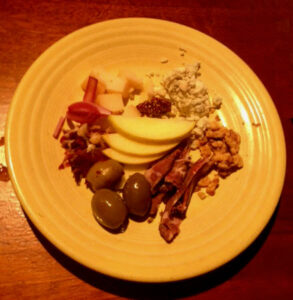

Pancetta recipe
Pancetta is one of the easiest and safest cured meats to make. An unsmoked Italian form of bacon, you can use it in the same way as bacon. The below recipe contains a spice mixture that Eric prefers, but you could also use garlic and spices like bay leaves, juniper berries, and thyme.
This recipe includes curing salt or, as a natural curing salt alternative, celery salt. Both contain nitrates. By using nitrates, you can use a much smaller quantity of salt to cure the pork belly. Curing salt also lends the characteristic unsmoked bacon flavor. If you do not use curing salt, your pancetta will not taste this way. Also, it will turn grey in color when cooked.
The Black Cat Farm booth at the Boulder Farmers’ Market sometimes carries pork belly. Feel free to ask if we have some if you stop by.
6 oz kosher salt
3 oz sugar
3 oz curing salt** or 1/4 celery seeds
1 teaspoon whole coriander (toasted and cracked, optional)
1 teaspoon fennel seeds (toasted, optional)
1.5 teaspoons whole peppercorns (toasted and cracked, optional)
1/2 teaspoon red pepper flakes
One 5 lb. piece of pork belly, preferably with the skin on
1. To make the dry cure, combine and mix the dry ingredients until the pink curing salt is uniformly distributed. (You can store the dry cure indefinitely in an airtight container.)
2. Rinse the pork belly and pat it dry. Salt it liberally with the dry cure so that it has a uniform even coating.
3. Place the coated pork belly in a two-gallon freezer bag, squeezing all the air out before sealing it.
4. Place the freezer bag in a container, cover it with a heavy weight, and store it in the refrigerator for 10 days. Turn the pork belly at least every other day and make sure the cure is evenly distributed.
5. After nine days, cut off a small corner of the pork belly, thoroughly rinse it, pat it dry, and then fry it. If it tastes delectable, rinse the rest of the pork belly thoroughly and pat it dry.
If the small piece could use more flavor, return the pork belly to the refrigerator and check the flavor each day in the same way.
6. After your pancetta is ready, you can store it in your refrigerator for two to three weeks by wrapping it tightly in plastic wrap. You can also store it in the freezer for up to 4 months if it is tightly wrapped and stored in a freezer bag.
**You can usually find curing salt locally at Savory Spice Shop or online.
Frisée salad with pancetta
Frisée pairs beautifully with pancetta and is in season now at the Black Cat Farm. It will also be periodically available from now until late fall.
Serves 4
2 cups diced raw pancetta
1 medium onion, julienned
2 tablespoons red wine vinegar
2 quarts of frisée hearts, torn up into bite-sized pieces
Crumbled blue cheese (Gorgonzola is traditional but Eric prefers Roquefort or Maytag Blue)
1. On medium heat, warm up a heavy-bottomed skillet until hot.
2. Add the pancetta and onion slices to the hot skillet until the pancetta and onion is fully cooked and crisp with the fat rendered, separated from the solids.
3. Place paper towels on a plate. Use a slotted spoon or skimmer to move the pancetta and onion from the skillet to the plate.
4. Place a paper towel over the pancetta and onions and press down on the top paper towel to remove excess grease.
5. From the skillet, measure out 1/4 cup of the pancetta fat and reserve. Remove the remaining fat from the skillet for disposal.
6. Heat the skillet again with medium heat until hot. Add the reserved pancetta fat to the skillet.
7. After the fat has warmed, add the red wine vinegar to deglaze the skillet. Scrape up the browned bits.
8. Add the frisée pieces to the pan, season with salt and pepper, and cook until barely wilted. Immediately remove the skillet with the wilted frisée from the heat.
9. Add equal portions of the frisée and skillet juices to four plates. Top with the pancetta and onions and sprinkle with the blue cheese crumbles.
